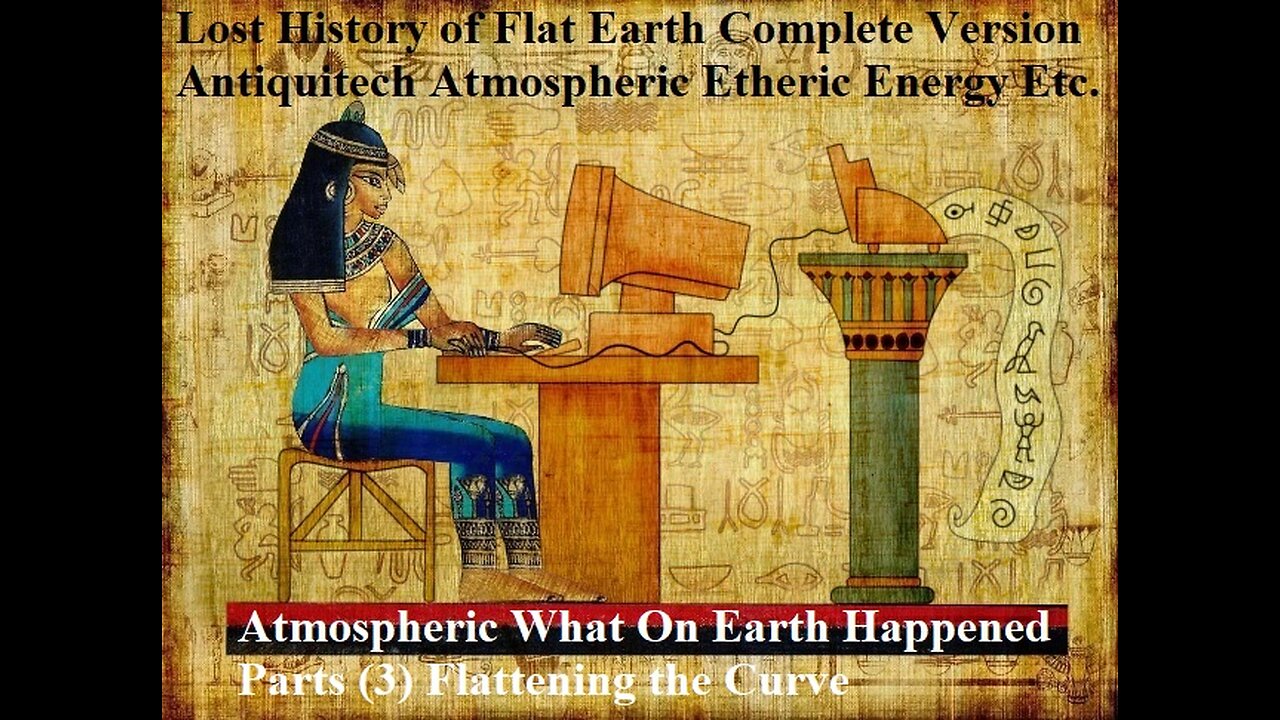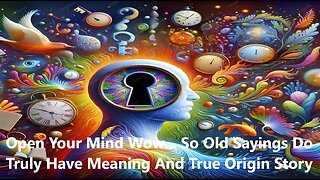Premium Only Content

Atmospheric What On Earth Happened Parts (3) Flattening The Curve Lost History Earth
The Lost History of Earth All 14 Video's By (Ewaranon) All Our Must See Video About Lost Earth and Everything we were taught about the Earth, History, Science, Space, Energy and our Civilization was a lie. This mind blowing documentary will shift your perspective of the world monumentally.
Mystery The World's Fairs Maybe the History we've been told is a lie! Were some ancient buildings built by a different race and their true history was covered up? Did ancient peoples have advanced forms of technology that have now been forgotten ? Was the massive kingdom of Tartaria visible on ancient maps much more advanced than we realize? This sub is an open forum for collaborative discussion of all topics "Tartaria" related, including Mud Flood, Tesla, AntiquiTech, Free Energy, Conspiracies, Hidden History, Etc.
I wonder if this video has been posted here before? If yes, then i am not sorry for posting it again, because its just one helluva epic video. If not, I highly recommend watching it if you are interested in perhaps how Tartarian technology worked. I am still thinking about all the stuff he said and points out to us. As its a lot to deal with and can shake one up. I find it fascinating though.
Could it be that this civilization, split off from our official historical line of development, is behind many of the events of the 20th century?
And what of the World's Fairs? Were a large proportion of the World's Fair Buildings actually built from scratch, as the official historiography claims? There is much to suggest that the robber barons of the industrial age not only hid once widespread technological knowledge from us, but that they also hijacked some of the impressive architectural masterpieces in which parts of this knowledge was displayed.
Some of the buildings from the World's Fairs still exist today, and they are obviously not made of plaster or similar fragile materials. Were they subsequently rebuilt to be permanent structures? Is it even possible that the elaborately designed Expo sites were built with the technological capabilities of the time within just a few months, only to be destroyed again a few months later after the exhibitions had ended? Or is it plausible that after a great catastrophe the worldwide remains of the preceding high culture were not only systematically destroyed, but also pressed into an image of history imposed on us?
Some available information suggests that even after the worldwide, game-changing event we call the Reset or Mud Flood, there still remained countless complete and beautiful cities that were conquered by a new power elite and then repurposed as "World's Fairs".
Especially in America, the so-called New World, the many Greco-Roman cities would have been difficult to explain because in contrast to Europe, the Americas do not have an official greco-roman history.
The more carefully one investigates, the more difficult it becomes to find plausible explanations for the construction and destruction of these extraordinary and huge exhibition areas.
The official version about the World's Fairs can be summarized as follows: People in the 19th century loved Greco-Roman architecture for reasons unknown, so it was extremely important to the architects who organized the World's Fairs between 1850 and about 1914 to build in a classical style.
(Note: With World War I, classical architectural ambitions in Europe ended abruptly and many exhibitions also did not take place as planned. It was only in the wake of fascism that there was a return to ancient design principles, but these were often implemented superficially and were mainly applied to a few representative magnificent buildings. After the Second World War, on the other hand, classical architecture was deliberately replaced with new trends - e.g. Bauhaus and Brutalism. Officially the intention was to create an aesthetic distance to fascism, but in all likelihood its purpose was to cut the connection to the Old World through soulless, brutalistic architecture.)
No effort was spared for the world's fairs, enormous amounts of work went into creating complex statues, ornaments, columns, parks, buildings, and even the world's largest organs. No expenses were spared in the making of these massive structures. Made of plaster and linen or hemp fibers, they were only intended to last for the duration of the Expo. However the attention to detail was so great that purely visually there seemed to be no difference between the Expo buildings and the classical splendor-buildings of antiquity. The purpose of the World's Fairs was to make the supposedly "new" technologies discovered during the Industrial Revolution palatable to the masses, to create new markets. In the end, most of the buildings were torn down, with only meadows or empty parks remaining.
More History Of Human Civilizations Around 400,000 years ago, the first evidence of the Neanderthals. Their bodies were adapted to the cold environments of Europe and Western Asia. Their distinctive facial features were some of the most human-like ever seen. They are famous for their massive body weight and big facial hair. These prehistoric ancestors were made for the cold. Then came us; 300,000 years ago, the first Homo Sapiens roamed the earth. The Only surviving species of the Homo Genus. But how did Homo Sapiens rise into a global dominance through the mechanism of civilization?
Humanity Written History was preceded by its prehistory, beginning with the Paleolithic Era ("Old Stone Age"), followed by the Neolithic Era ("New Stone Age"). The Neolithic saw the Agricultural Revolution begin, between 10,000 and 5000 BCE, in the Near East's Fertile Crescent. During this period, humans began the systematic husbandry of plants and animals. As agriculture advanced, most humans transitioned from a nomadic to a settled lifestyle as farmers in permanent settlements. The relative security and increased productivity provided by farming allowed communities to expand into increasingly larger units, fostered by advances in transportation.
Whether in prehistoric or historic times, people always needed to be near reliable sources of drinking water. Settlements developed as early as 4,000 BCE in Iran, in Mesopotamia, in the Indus River valley on the Indian subcontinent, on the banks of Egypt's Nile River, and along China's rivers. As farming developed, grain agriculture became more sophisticated and prompted a division of labour to store food between growing seasons. Labour divisions led to the rise of a leisured upper class and the development of cities, which provided the foundation for civilization. The growing complexity of human societies necessitated systems of accounting and writing. Hinduism developed in the late Bronze Age on the Indian subcontinent. The Axial Age witnessed the introduction of religions such as Buddhism, Taoism, Confucianism, and Jainism. Video Is not about Creationism vs. Evolution and Either dust or lightening started it all. video is more about world timeline history as place's and people's and land's and different kingdom's in time's.
With civilizations flourishing, ancient history ("Antiquity," including the Classical Age and Golden Age of India, up to about 500 CE) saw the rise and fall of empires. Post-classical history (the "Middle Ages," c. 500–1500 CE,) witnessed the rise of Christianity, the Islamic Golden Age (c. 750 CE – c. 1258 CE), and the Timurid and Italian Renaissances (from around 1300 CE). The mid-15th-century introduction of movable-type printing in Europe revolutionized communication and facilitated ever wider dissemination of information, hastening the end of the Middle Ages and ushering in the Scientific Revolution. The early modern period, sometimes referred to as the "European Age and Age of the Islamic Gunpowders", from about 1500 to 1800, included the Age of Discovery and the Age of Enlightenment. By the 18th century, the accumulation of knowledge and technology had reached a critical mass that brought about the Industrial Revolution and began the late modern period, which started around 1800 and has continued through the present.
This scheme of historical periodization (dividing history into Antiquity, Post-Classical, Early Modern, and Late Modern periods) was developed for, and applies best to, the history of the Old World, particularly Europe and the Mediterranean. Outside this region, including ancient China and ancient India, historical timelines unfolded differently. However, by the 18th century, due to extensive world trade and colonization, the histories of most civilizations had become substantially intertwined, a process known as globalization. In the last quarter-millennium, the rates of growth of population, knowledge, technology, communications, commerce, weapon destructiveness, and environmental degradation have greatly accelerated, creating unprecedented opportunities and perils that now confront the planet's human communities.
Prehistory, also known as pre-literary history, is the period of human history between the use of the first stone tools by hominins c. 3.3 million years ago and the invention of writing systems. The use of symbols, marks, and images appears very early among humans, but the earliest known writing systems appeared c. 5000 years ago and it took thousands of years for writing systems to be widely adopted. In some human cultures, writing systems were not used until the nineteenth century and, in a few, are not even used until the present. The end of prehistory therefore came at very different dates in different places, and the term is less often used in discussing societies where prehistory ended relatively recently.
Ancient history is the aggregate of past events from the beginning of writing and recorded human history and extending as far as post-classical history. The phrase may be used either to refer to the period of time or the academic discipline.
The span of recorded history is roughly 5,000 years, beginning with the Sumerian cuneiform script, with the oldest coherent texts from about 2600 BC. Ancient history covers all continents inhabited by humans in the period 3000 BC – AD 500.
The broad term "ancient history" is not to be confused with "classical antiquity". The term classical antiquity is often used to refer to Western history in the Ancient Mediterranean from the beginning of recorded Greek history in 776 BC (first Olympiad). This roughly coincides with the traditional date of the founding of Rome in 753 BC, the beginning of the history of ancient Rome, and the beginning of the Archaic period in Ancient Greece.
The academic term "history" is fundamentally the study of the past, and can be either scientific (archaeology, with the examination of physical evidence) or humanistic (the study of history through texts, poetry, and linguistics).
Although the ending date of ancient history is disputed, some Western scholars use the fall of the Western Roman Empire in 476 AD (the most used), the closure of the Platonic Academy in 529 AD, the death of the emperor Justinian I in 565 AD, the coming of Islam, or the rise of Charlemagne as the end of ancient and Classical European history. Outside of Europe, there have been difficulties with the 450–500 time frame for the transition from ancient to post-classical times.
During the time period of ancient history (starting roughly from 3000 BC), the world population was already exponentially increasing due to the Neolithic Revolution, which was in full progress. According to HYDE estimates from the Netherlands, world population increased exponentially in this period. In 10,000 BC in prehistory, the world population had stood at 2 million, rising to 45 million by 3,000 BC. By the rise of the Iron Age in 1,000 BC, the population had risen to 72 million. By the end of the period in 500 AD, the world population is thought to have stood at 209 million. In 3,500 years, the world population increased by 100 times.
History of the Ancient World is a bare-bones introduction to the Ancient Period from around 4000 BCE until just after the Fall of Rome, around 500 CE. The focus is global, instead of only the Mediterranean region.
Other focuses:
Ancient Mesopotamia, Persian empires, Ancient Egypt, African civilizations, East and South Asia, Ancient Americas, Classical Antiquity (Ancient Greece and Rome), and European barbarian tribes.
Post-classical history, as used in global history, generally runs from about 500 CE to 1500 CE (roughly corresponding to the European Middle Ages). The period is characterized by the expansion of civilizations geographically and development of trade networks between civilizations.
In Asia, the spread of Islam created a new empire and Islamic Golden Age with trade among the Asian, African and European continents, and advances in science in the medieval Islamic world. East Asia experienced the full establishment of power of Imperial China, which established several prosperous dynasties influencing Korea, Vietnam, and Japan. Religions such as Buddhism and Neo-Confucianism spread in the region. Gunpowder was developed in China during the post-classical era. The Mongol Empire connected Europe and Asia, creating safe trade and stability between the two regions. In total the population of the world doubled in the time period from approximately 210 million in 500 AD to 461 million in 1500 AD. Population generally grew steadily throughout the period but endured some incidental declines in events including the Plague of Justinian, the Mongol Invasions, and the Black Death.
This period is also called the medieval era, post-antiquity era, post-ancient era, or pre-modern era.
This documentary about the Middle Ages is a bare-bones introduction to the Postclassical Period from around the year 500 until around 1500. The focus is global, instead of only Europe. It is 2nd in our 4-part TIME PERIOD series
Main focuses:
West African Kingdoms, Middle Ages, Rise of Islam, Delhi Sultanate, Khmer Empire, Sui, Tang, and Song Dynasties, Japanese Shogunates, Crusades, Black Death, Mongol Empire, Mississippians, Mayans and Aztecs, Incans, Melanesians and Polynesians, Fall of Constantinople.
The early modern period of modern history follows the late Middle Ages of the post-classical era. Although the chronological limits of this period are open to debate, the timeframe spans the period after the late post-classical or Middle Ages (c. 1400–1500) through the beginning of the Age of Revolutions (c. 1800). It is variously demarcated by historians as beginning with the Ottoman conquest of Constantinople in 1453, the Renaissance period in Europe and Timurid Central Asia, the Muslim conquests in the Indian subcontinent, the end of the Crusades, the Age of Discovery (especially the voyages of Christopher Columbus beginning in 1492 but also Vasco da Gama's discovery of the sea route to India in 1498), and ending around the French Revolution in 1789, or Napoleon's rise to power.
Early modern trends in various regions of the world represented a shift away from medieval modes of organization, politically and economically. Feudalism declined in Europe, and Christians and Christendom saw the end of the Crusades and of religious unity under the Roman Catholic Church. The old order was destabilized by the Protestant Reformation, which caused a backlash that expanded the Inquisition and sparked the disastrous European Wars of Religion, which included the especially bloody Thirty Years' War and ended with the establishment of the modern international system in the Peace of Westphalia. Along with the European colonization of the Americas, this period also contained the Commercial Revolution and the Golden Age of Piracy.
This documentary about the Early Modern Period is a bare-bones introduction to the world after the Middle Ages, from around the year 1500 until around 1800. The focus is global, instead of only Europe. It is 3rd in our 4-part TIME PERIOD series
Main focuses:
Ming dynasty, Qing dynasty, Japanese unification, Invasion of Korea, Mughals and Marathas, Malacca Sultanate, Durrani Empire, Ottoman expansion, Thirty Years' War, Seven Year's War, War of Spanish Succession, Renaissance, Scientific Revolution, Enlightenment, Protestant Reformation, Colonization of the Americas, French Revolution.
In many periodizations of human history, the late modern period followed the early modern period. It began approximately in the mid-18th century and depending on the author either ended with the beginning of contemporary history after World War II, or includes that period up to the present day. Notable historical milestones included the American Revolution, the French Revolution, the Industrial Revolution, and the Russian Revolution. It took all of human history up to 1804 for the world's population to reach 1 billion; the next billion came just over a century later, in 1927.
This documentary about the Late Modern Period is a bare-bones introduction to the Time Period from around the year 1800 until around the present. The focus is global, instead of only Europe.
Industrial Revolution, Napoleonic Wars, Revolutions of 1848, German and Italian Unification, World War I and World War II, Chinese Civil War, Russian Revolution, Russian Civil War, Cold War, Scramble for Africa, American Civil War, Space Race, Gilded Age, the Great Depression, and other topics!
https://www.southampton.ac.uk/~cpd/history.html
An Evolutionary Timeline of Homo Sapiens Scientists share the findings that helped them pinpoint key moments in the rise of our species The long evolutionary journey that created modern humans began with a single step—or more accurately—with the ability to walk on two legs. One of our earliest-known ancestors, Sahelanthropus, began the slow transition from ape-like movement some six million years ago, but Homo sapiens wouldn’t show up for more than five million years. During that long interim, a menagerie of different human species lived, evolved and died out, intermingling and sometimes interbreeding along the way. As time went on, their bodies changed, as did their brains and their ability to think, as seen in their tools and technologies.
To understand how Homo sapiens eventually evolved from these older lineages of hominins, the group including modern humans and our closest extinct relatives and ancestors, scientists are unearthing ancient bones and stone tools, digging into our genes and recreating the changing environments that helped shape our ancestors’ world and guide their evolution.
These lines of evidence increasingly indicate that H. sapiens originated in Africa, although not necessarily in a single time and place. Instead it seems diverse groups of human ancestors lived in habitable regions around Africa, evolving physically and culturally in relative isolation, until climate driven changes to African landscapes spurred them to intermittently mix and swap everything from genes to tool techniques. Eventually, this process gave rise to the unique genetic makeup of modern humans.
“East Africa was a setting in foment—one conducive to migrations across Africa during the period when Homo sapiens arose,” says Rick Potts, director of the Smithsonian’s Human Origins Program. “It seems to have been an ideal setting for the mixing of genes from migrating populations widely spread across the continent. The implication is that the human genome arose in Africa. Everyone is African, and yet not from any one part of Africa.”
New discoveries are always adding key waypoints to the chart of our human journey. This timeline of Homo sapiens features some of the best evidence documenting how we evolved.
550,000 to 750,000 Years Ago: The Beginning of the Homo sapiens Lineage
Homo heidelbergensis
A facial reconstruction of Homo heidelbergensis, a popular candidate as a common ancestor for modern humans, Neanderthals and Denisovans John
Gurche
Genes, rather than fossils, can help us chart the migrations, movements and evolution of our own species—and those we descended from or interbred with over the ages.
The oldest-recovered DNA of an early human relative comes from Sima de los Huesos, the “Pit of Bones.” At the bottom of a cave in Spain’s Atapuerca Mountains scientists found thousands of teeth and bones from 28 different individuals who somehow ended up collected en masse. In 2016, scientists painstakingly teased out the partial genome from these 430,000-year-old remains to reveal that the humans in the pit are the oldest known Neanderthals, our very successful and most familiar close relatives. Scientists used the molecular clock to estimate how long it took to accumulate the differences between this oldest Neanderthal genome and that of modern humans, and the researchers suggest that a common ancestor lived sometime between 550,000 and 750,000 years ago.
Pinpoint dating isn't the strength of genetic analyses, as the 200,000-year margin of error shows. “In general, estimating ages with genetics is imprecise,” says Joshua Akey, who studies evolution of the human genome at Princeton University. “Genetics is really good at telling us qualitative things about the order of events, and relative time frames.” Before genetics, these divergence dates were estimated by the oldest fossils of various lineages scientists found. In the case of H. sapiens, known remains only date back some 300,000 years, so gene studies have located the divergence far more accurately on our evolutionary timeline than bones alone ever could.
Though our genes clearly show that modern humans, Neanderthals and Denisovans—a mysterious hominin species that left behind substantial traces in our DNA but, so far, only a handful of tooth and bone remains—do share a common ancestor, it’s not apparent who it was. Homo heidelbergensis, a species that existed from 200,000 to 700,000 years ago, is a popular candidate. It appears that the African family tree of this species leads to Homo sapiens while a European branch leads to Homo neanderthalensis and the Denisovans.
More ancient DNA could help provide a clearer picture, but finding it is no sure bet. Unfortunately, the cold, dry and stable conditions best for long-term preservation aren’t common in Africa, and few ancient African human genomes have been sequenced that are older than 10,000 years.
“We currently have no ancient DNA from Africa that even comes near the timeframes of our evolution—a process that is likely to have largely taken place between 800,000 and 300,000 years ago,” says Eleanor Scerri, an archaeological scientist at the Max Planck Institute for the Science of Human History in Germany.
300,000 Years Ago: Fossils Found of Oldest Homo sapiens
Homo Sapiens Skull Reconstruction
Two views of a composite reconstruction of the earliest known Homo sapiens fossils from Jebel Irhoud Philipp Gunz, MPI EVA Leipzig via CC-BY-SA 2.0
As the physical remains of actual ancient people, fossils tell us most about what they were like in life. But bones or teeth are still subject to a significant amount of interpretation. While human remains can survive after hundreds of thousands of years, scientists can’t always make sense of the wide range of morphological features they see to definitively classify the remains as Homo sapiens, or as different species of human relatives.
Fossils often boast a mixture of modern and primitive features, and those don’t evolve uniformly toward our modern anatomy. Instead, certain features seem to change in different places and times, suggesting separate clusters of anatomical evolution would have produced quite different looking people.
No scientists suggest that Homo sapiens first lived in what’s now Morocco, because so much early evidence for our species has been found in both South Africa and East Africa. But fragments of 300,000-year-old skulls, jaws, teeth and other fossils found at Jebel Irhoud, a rich site also home to advanced stone tools, are the oldest Homo sapiens remains yet found.
The remains of five individuals at Jebel Irhoud exhibit traits of a face that looks compellingly modern, mixed with other traits like an elongated brain case reminiscent of more archaic humans. The remains’ presence in the northwestern corner of Africa isn’t evidence of our origin point, but rather of how widely spread humans were across Africa even at this early date.
Other very old fossils often classified as early Homo sapiens come from Florisbad, South Africa (around 260,000 years old), and the Kibish Formation along Ethiopia’s Omo River (around 195,000 years old).
The 160,000-year-old skulls of two adults and a child at Herto, Ethiopia, were classified as the subspecies Homo sapiens idaltu because of slight morphological differences including larger size. But they are otherwise so similar to modern humans that some argue they aren’t a subspecies at all. A skull discovered at Ngaloba, Tanzania, also considered Homo sapiens, represents a 120,000-year-old individual with a mix of archaic traits and more modern aspects like smaller facial features and a further reduced brow.
Debate over the definition of which fossil remains represent modern humans, given these disparities, is common among experts. So much so that some seek to simplify the characterization by considering them part of a single, diverse group.
“The fact of the matter is that all fossils before about 40,000 to 100,000 years ago contain different combinations of so called archaic and modern features. It’s therefore impossible to pick and choose which of the older fossils are members of our lineage or evolutionary dead ends,” Scerri suggests. “The best model is currently one in which they are all early Homo sapiens, as their material culture also indicates.”
As Scerri references, African material culture shows a widespread shift some 300,000 years ago from clunky, handheld stone tools to the more refined blades and projectile points known as Middle Stone Age toolkits.
So when did fossils finally first show fully modern humans with all representative features? It’s not an easy answer. One skull (but only one of several) from Omo Kibish looks much like a modern human at 195,000 years old, while another found in Nigeria’s Iwo Eleru cave, appears very archaic, but is only 13,000 years old. These discrepancies illustrate that the process wasn’t linear, reaching some single point after which all people were modern humans.
300,000 Years Ago: Artifacts Show a Revolution in Tools
Stone Tools
The two objects on the right are pigments used between 320,000 and 500,000 years ago in East Africa. All other objects are stone tools used during the same time period in the same area. Human Origins Program, NMNH, Smithsonian
Institution
Our ancestors used stone tools as long as 3.3 million years ago and by 1.75 million years ago they’d adopted the Acheulean culture, a suite of chunky handaxes and other cutting implements that remained in vogue for nearly 1.5 million years. As recently as 400,000 years ago, thrusting spears used during the hunt of large prey in what is now Germany were state of the art. But they could only be used up close, an obvious and sometimes dangerous limitation.
Even as they acquired the more modern anatomy seen in living humans, the ways our ancestors lived, and the tools they created, changed as well.
Humans took a leap in tool tech with the Middle Stone Age some 300,000 years ago by making those finely crafted tools with flaked points and attaching them to handles and spear shafts to greatly improve hunting prowess. Projectile points like those Potts and colleagues dated to 298,000 to 320,000 years old in southern Kenya were an innovation that suddenly made it possible to kill all manner of elusive or dangerous prey. “It ultimately changed how these earliest sapiens interacted with their ecosystems, and with other people,” says Potts.
Scrapers and awls, which could be used to work animal hides for clothing and to shave wood and other materials, appeared around this time. By at least 90,000 years ago barbed points made of bone—like those discovered at Katanda, Democratic Republic of the Congo—were used to spearfish
As with fossils, tool advancements appear in different places and times, suggesting that distinct groups of people evolved, and possibly later shared, these tool technologies. Those groups may include other humans who are not part of our own lineage.
Last year a collection including sophisticated stone blades was discovered near Chennai, India, and dated to at least 250,000 years ago. The presence of this toolkit in India so soon after modern humans appeared in Africa suggests that other species may have also invented them independently—or that some modern humans spread the technology by leaving Africa earlier than most current thinking suggests.
100,000 to 210,000 Years Ago: Fossils Show Homo sapiens Lived Outside of Africa
Skull From Qafzeh
A skull found in Qafzeh, from the collection at the American Museum of Natural History Wapondaponda via Wikipedia under CC BY-SA 3.0
Many genetic analyses tracing our roots back to Africa make it clear that Homo sapiens originated on that continent. But it appears that we had a tendency to wander from a much earlier era than scientists had previously suspected.
A jawbone found inside a collapsed cave on the slopes of Mount Carmel, Israel, reveals that modern humans dwelt there, alongside the Mediterranean, some 177,000 to 194,000 years ago. Not only are the jaw and teeth from Misliya Cave unambiguously similar to those seen in modern humans, they were found with sophisticated handaxes and flint tools.
Other finds in the region, including multiple individuals at Qafzeh, Israel, are dated later. They range from 100,000 to 130,000 years ago, suggesting a long presence for humans in the region. At Qafzeh, human remains were found with pieces of red ocher and ocher-stained tools in a site that has been interpreted as the oldest intentional human burial.
Among the limestone cave systems of southern China, more evidence has turned up from between 80,000 and 120,000 years ago. A 100,000-year-old jawbone, complete with a pair of teeth, from Zhirendong retains some archaic traits like a less prominent chin, but otherwise appears so modern that it may represent Homo sapiens. A cave at Daoxian yielded a surprising array of ancient teeth, barely distinguishable from our own, which suggest that Homo sapiens groups were already living very far from Africa from 80,000 to 120,000 years ago.
Even earlier migrations are possible; some believe evidence exists of humans reaching Europe as long as 210,000 years ago. While most early human finds spark some scholarly debate, few reach the level of the Apidima skull fragment, in southern Greece, which may be more than 200,000 years old and might possibly represent the earliest modern human fossil discovered outside of Africa. The site is steeped in controversy, however, with some scholars believing that the badly preserved remains look less those of our own species and more like Neanderthals, whose remains are found just a few feet away in the same cave. Others question the accuracy of the dating analysis undertaken at the site, which is tricky because the fossils have long since fallen out of the geological layers in which they were deposited.
While various groups of humans lived outside of Africa during this era, ultimately, they aren’t part of our own evolutionary story. Genetics can reveal which groups of people were our distant ancestors and which had descendants who eventually died out.
“Of course, there could be multiple out of Africa dispersals,” says Akey. “The question is whether they contributed ancestry to present day individuals and we can say pretty definitely now that they did not.”
50,000 to 60,000 Years Ago: Genes and Climate Reconstructions Show a Migration Out of Africa
Arabian Peninsula
A digital rendering of a satellite view of the Arabian Peninsula, where humans are believed to have migrated from Africa roughly 55,000 years ago.
All living non-Africans, from Europeans to Australia’s aboriginal people, can trace most of their ancestry to humans who were part of a landmark migration out of Africa beginning some 50,000 to 60,000 years ago, according to numerous genetic studies published in recent years. Reconstructions of climate suggest that lower sea levels created several advantageous periods for humans to leave Africa for the Arabian Peninsula and the Middle East, including one about 55,000 years ago.
“Just by looking at DNA from present day individuals we’ve been able to infer a pretty good outline of human history,” Akey says. “A group dispersed out of Africa maybe 50 to 60 thousand years ago, and then that group traveled around the world and eventually made it to all habitable places of the world.”
While earlier African emigres to the Middle East or China may have interbred with some of the more archaic hominids still living at that time, their lineage appears to have faded out or been overwhelmed by the later migration.
15,000 to 40,000 Years Ago: Genetics and Fossils Show Homo sapiens Became the Only Surviving Human Species
Homo floresiensis
A facial reconstruction of Homo floresiensis, a diminutive early human that may have lived until 50,000 years ago John Gurche
For most of our history on this planet, Homo sapiens have not been the only humans. We coexisted, and as our genes make clear frequently interbred with various hominin species, including some we haven’t yet identified. But they dropped off, one by one, leaving our own species to represent all humanity. On an evolutionary timescale, some of these species vanished only recently.
On the Indonesian island of Flores, fossils evidence a curious and diminutive early human species nicknamed “hobbit.” Homo floresiensis appear to have been living until perhaps 50,000 years ago, but what happened to them is a mystery. They don’t appear to have any close relation to modern humans including the Rampasasa pygmy group, which lives in the same region today.
Neanderthals once stretched across Eurasia from Portugal and the British Isles to Siberia. As Homo sapiens became more prevalent across these areas the Neanderthals faded in their turn, being generally consigned to history by some 40,000 years ago. Some evidence suggests that a few die-hards might have held on in enclaves, like Gibraltar, until perhaps 29,000 years ago. Even today traces of them remain because modern humans carry Neanderthal DNA in their genome.
Our more mysterious cousins, the Denisovans, left behind so few identifiable fossils that scientists aren’t exactly sure what they looked like, or if they might have been more than one species. A recent study of human genomes in Papua New Guinea suggests that humans may have lived with and interbred with Denisovans there as recently as 15,000 years ago, though the claims are controversial. Their genetic legacy is more certain. Many living Asian people inherited perhaps 3 to 5 percent of their DNA from the Denisovans.
Despite the bits of genetic ancestry they contributed to living people, all of our close relatives eventually died out, leaving Homo sapiens as the only human species. Their extinctions add one more intriguing, perhaps unanswerable question to the story of our evolution—why were we the only humans to survive?
Thanks From New World Order Year Zero !
Buildings and cities are made to grow old, to outlast people, and to be a testament to these cultural histories. They’re a yardstick for a culture’s ability to endure. When they’re not given the chance to do this, the contradiction can break something loose, and send people scavenging for cultural memory that feels ancient enough to anchor them in an uncertain now.
If anything, the world is consistent; no one in any country has a clue how to rebuild the castles found in their own countries.
Real Timeline Of Deception Part 0 Exploring Tartaria 1000 Years
Exploring Tartaria - Old World Secrets Revealed
https://rumble.com/v2u8ef4-real-timeline-of-deception-part-0-exploring-tartaria-1000-years-added-to-ou.html
Real Timeline Of Deception Part 1 Exploring Tartaria 1000 Years
The Timeline Deception - Part I - Exploring Tartaria
https://rumble.com/v2ua8sa-real-timeline-of-deception-part-1-exploring-tartaria-1000-years-added-to-ou.html
Real Timeline Of Deception Part 2 Exploring Tartaria 1000 Years
The Timeline Deception - Part II - Exploring Tartaria
https://rumble.com/v2ubf4w-real-timeline-of-deception-part-2-exploring-tartaria-1000-years-added-to-ou.html
Real Timeline Of Deception Part 3 Exploring Tartaria 1000 Years
The King of Tartaria - Exploring Tartaria
https://rumble.com/v2ueih6-real-timeline-of-deception-part-3-exploring-tartaria-1000-years-added-to-ou.html
Real Timeline Of Deception Part 4 Exploring Tartaria 1000 Years
The Saints - Relics, Reliquaries, & The First Resurrection
https://rumble.com/v2ugl92-real-timeline-of-deception-part-4-exploring-tartaria-1000-years-added-to-ou.html
Real Timeline Of Deception Part 5 Exploring Tartaria 1000 Years
The Saints - The Ruling Class - Exploring Tartaria
https://rumble.com/v2uij7w-real-timeline-of-deception-part-5-exploring-tartaria-1000-years-added-to-ou.html
Real Timeline Of Deception Part 6 Exploring Tartaria 1000 Years
From Atheism, Agnosticism, New Age, Protestantism, to Roman Catholicism
https://rumble.com/v2ujvr6-real-timeline-of-deception-part-6-exploring-tartaria-1000-years-added-to-ou.html
Real Timeline Of Deception Part 7 Exploring Tartaria 1000 Years
The Millennial Kingdom of God - Exploring Tartaria
https://rumble.com/v2uldss-real-timeline-of-deception-part-7-exploring-tartaria-1000-years-added-to-ou.html
Real Timeline Of Deception Part 8 Exploring Tartaria 1000 Years
Magic of the White City 1893 Chicago World's Fair
https://rumble.com/v2un20g-real-timeline-of-deception-part-8-exploring-tartaria-1000-years-added-to-ou.html
Real Timeline Of Deception Part 9 Exploring Tartaria 1000 Years
1000 Years Added To Our History & Dark Ages Never Existed
https://rumble.com/v2uo07i-real-timeline-of-deception-part-9-exploring-tartaria-1000-years-added-to-ou.html
Real Timeline Of Deception Part 10 Exploring Tartaria 1000 Years
Church History - Complete Documentary AD 33 to Present
https://rumble.com/v2uprfu-real-timeline-of-deception-part-10-exploring-tartaria-1000-years-added-to-o.html
Real Timeline Of Deception Part 11 Exploring Tartaria 1000 Years
Christmas Unveiled - Pied Piper - Templars Secret - Saturn's Workshop - Giants Stealing Children
https://rumble.com/v2urmd0-real-timeline-of-deception-part-11-exploring-tartaria-1000-years-added-to-o.html
Real Timeline Of Deception Part 12 Exploring Tartaria 1000 Years
Ancient Cloning Factories - Foundlings - Incubators - Test-Tube Babies
https://rumble.com/v2uu8ck-real-timeline-of-deception-part-12-exploring-tartaria-1000-years-added-to-o.html
Real Timeline Of Deception Part 13 Exploring Tartaria 1000 Years
Homunculus Unveiled - Jesus - Artificial Generation - Liber Vaccae - Lost Esoteric Secrets
Archaix Chronology Anunnaki Sumerian Gods Crystalinks Timelines 2040B.C. 2046A.D.
Archaix 2.0 Doomsday Chronology Five color charts with extensive Legend-chronology; exhibits 62 dates involving 300 events in linear timeline combining the Phoenix and Nemesis X Object appearances, the Mayan Long-Count baktuns and the Anunnaki NER 600 year periods, a history spanning over 74 centuries to May 2040 and November 2046.
The Lost History of Earth (Ewaranon) W0W - A Must See Video Lost Earth
Everything we were taught about the Earth, History, Science, Space, Energy and our Civilization was a lie. This mind blowing documentary will shift your perspective of the world monumentally.
The Secret Life of Symbols with Jordan Maxwell Knowledge of the Heavens, Life on Earth
Ancient Religions From Alpha To Stone Age To Omega To Modern Times To Infinity
This 11.5 Hrs. Full Documentary With Sound Is About Ancient Religions From Alpha To Stone Age To Omega To Modern Times To Infinity.
Everything we were taught about the Earth, History, Science, Space, Energy and our Civilization was a lie. This mind blowing documentary will shift your perspective of the world monumentally.
This is a chronological list of international or colonial world's fairs.
https://en.wikipedia.org/wiki/List_of_world's_fairs
World's Fair History Quick List
https://americasbesthistory.com/expolist.html
Everything we were taught about the Earth, History, Science, Space, Energy and our Civilization was a lie. This mind blowing documentary will shift your perspective of the world monumentally.
Proofs Earth Is Not A Spinning Ball What The Hell Happened 200 Times Collection
Proofs Earth Is Not A Spinning Ball When a photo of spherical Earth is pointed out to flat-earthers, they will dismiss it as CGI in the blink of an eye; even if they haven’t done any analysis at all. They do this because their belief in flat-Earth is not evidence-based, and any evidence contrary to their beliefs needs to be invalidated no matter how. They are so used to doing it, and sometimes they become confused by it themselves, to the point that they would take the slightest hint of digital manipulation of any picture of the Earth as evidence of the flat Earth.
Mystery The World's Fairs 00 This Evidence Hidden History Chronological All World’s Fair's - https://rumble.com/v49zfro-mystery-the-worlds-fairs-this-evidence-hidden-history-chronological-all-wor.html
Mystery The World's Fairs 01 London 1851 Crystal Palace Works Industry All Nations - https://rumble.com/v49xr6f-mystery-the-worlds-fairs-london-1851-crystal-palace-works-industry-all-nati.html
Mystery The World's Fairs 02 Paris 1855 World's Fair L'Exposition Universelle de Paris # 1 - https://rumble.com/v49wmff-mystery-the-worlds-fairs-paris-1855-worlds-fair-lexposition-universelle-de-.html
Mystery The World's Fairs 03 Paris 1867 World's Fair L'Exposition Universelle de Paris # 2 - https://rumble.com/v49vttt-mystery-the-worlds-fairs-paris-1867-worlds-fair-lexposition-universelle-de-.html
Mystery The World's Fairs 04 Philadelphia 1876 Fair Centennial International Exposition - https://rumble.com/v49us5z-mystery-the-worlds-fairs-philadelphia-1876-fair-centennial-international-ex.html
Mystery The World's Fairs 05 Paris 1878 World's Fair L'Exposition Universelle de Paris # 3 - https://rumble.com/v49soh6-mystery-the-worlds-fairs-paris-1878-worlds-fair-lexposition-universelle-de-.html
Mystery The World's Fairs 06 Paris 1889 World's Fair Exposition Universelle de Paris # 4 - https://rumble.com/v49pdu3-mystery-the-worlds-fairs-paris-1889-worlds-fair-exposition-universelle-de-p.html
Mystery The World's Fairs 07 Chicago 1893 World's Fair World's Columbian Exposition - https://rumble.com/v49ryc5-mystery-the-worlds-fairs-chicago-1893-worlds-fair-worlds-columbian-expositi.html
Mystery The World's Fairs 08 Lyon 1894 Fair L'Exposition Internationale et Coloniale - https://rumble.com/v49qjd3-mystery-the-worlds-fairs-lyon-1894-fair-lexposition-internationale-et-colon.html
Mystery The World's Fairs 09 Nashville Tennessee 1897 Centennial International Exposition - https://rumble.com/v49obhi-mystery-the-worlds-fairs-nashville-tennessee-1897-centennial-international-.html
Mystery The World's Fairs 10 Omaha 1898 Nebraska Trans-Mississippi Exposition Part 1 - https://rumble.com/v49kvne-mystery-the-worlds-fairs-omaha-1898-nebraska-trans-mississippi-exposition-p.html
Mystery The World's Fairs 11 Omaha 1898 Nebraska Trans-Mississippi Exposition Part 2 - https://rumble.com/v49ls22-mystery-the-worlds-fairs-omaha-1898-nebraska-trans-mississippi-exposition-p.html
Mystery The World's Fairs 12 Buffalo 1901 New York World's Fair Pan American Exposition - https://rumble.com/v49dg39-mystery-the-worlds-fairs-buffalo-1901-new-york-worlds-fair-pan-american-exp.html
Mystery The World's Fairs 13 St. Louis 1904 World's Fair Louisiana Purchase Exposition - https://rumble.com/v49h2n9-mystery-the-worlds-fairs-st.-louis-1904-worlds-fair-louisiana-purchase-expo.html
Mystery The World's Fairs 14 Louisiana 1904 Purchase Exposition St. Louis World's Fair - https://rumble.com/v49bv7t-mystery-the-worlds-fairs-louisiana-1904-purchase-exposition-st.-louis-world.html
Mystery The World's Fairs 15 Seattle 1909 World's Fair Alaska Yukon Pacific Exposition - https://rumble.com/v499353-mystery-the-worlds-fairs-seattle-1909-worlds-fair-alaska-yukon-pacific-expo.html
Mystery The World's Fairs 16 San Francisco 1915 Panama-Pacific International Exposition - https://rumble.com/v49aa13-mystery-the-worlds-fairs-san-francisco-1915-panama-pacific-international-ex.html
Mystery The World's Fairs 17 1962 Seattle Chronological All International World’s Fair's - https://rumble.com/v49is0f-mystery-the-worlds-fairs-1962-seattle-chronological-all-international-world.html
Antiquitech Tartarian Empire Old World's Fairs 18 Before The World's Fair 1851 Thru 1974 - https://rumble.com/v4968hi-antiquitech-tartarian-empire-old-worlds-fairs-before-the-worlds-fair-1851-t.html
Chicago Old Museum Tell About 1,000 Year 19 Old World History Of 1893 World's Fair - https://rumble.com/v2cphwy-chicago-old-museum-tell-about-1000-year-old-world-history-of-1893-worlds-fa.html
Chilaga Where Chicago Is Now On Map 20 of America and 1893 World’s Columbian Exposition - https://rumble.com/v2cqmdc-chilaga-where-chicago-is-now-on-map-of-america-and-1893-worlds-columbian-ex.html
Antiquitech Tartarian Empire Greatest Story 21 Ever Un-told Rewriting Recorded History - https://rumble.com/v36porm-antiquitech-tartarian-empire-greatest-story-ever-un-told-rewriting-recorded.html
Everything we were taught about the Earth, History, Science, Space, Energy and our Civilization was a lie. This mind blowing documentary will shift your perspective of the world monumentally.
Atmospheric What On Earth Happened Parts (1) Turning Inward Lost History Earth - https://rumble.com/v4a88i9-atmospheric-what-on-earth-happened-parts-1turning-inward-lost-history-earth.html
Atmospheric What On Earth Happened Parts (2) Of Maps and Magicians Lost History - https://rumble.com/v4a9rrc-atmospheric-what-on-earth-happened-parts-2ofmapsandmagicians-lost-history.html
Atmospheric What On Earth Happened Parts (3) Flattening The Curve Lost History Earth - https://rumble.com/v4abbl6-atmospheric-what-on-earth-happened-parts-3flattening-thecurve-lost-history-.html
Atmospheric What On Earth Happened Parts (4) Vanishing Points and The Old Clock - https://rumble.com/v4acotu-atmospheric-what-on-earth-happened-parts-4vanishing-pointsand-the-oldclock.html
Atmospheric What On Earth Happened Parts (5) The Red Shield Lost History Earth - https://rumble.com/v4ady4x-atmospheric-what-on-earth-happened-parts-5thered-shield-lost-history-earth.html
Atmospheric What On Earth Happened Parts (6) Infiltration Instead of Invasion - https://rumble.com/v4aepeu-atmospheric-what-on-earth-happened-parts-6infiltrationinstead-ofinvasion.html
Atmospheric What On Earth Happened Parts (7) Eyes Wide Open Lost History Earth - https://rumble.com/v4afpa9-atmospheric-what-on-earth-happened-parts-7eyes-wide-open-lost-history-earth.html
Atmospheric What On Earth Happened Parts (8) The Looking Glass Lost History Earth - https://rumble.com/v4ah5kc-atmospheric-what-on-earth-happened-parts-8thelooking-glass-lost-history-ear.html
Atmospheric What On Earth Happened Parts (9) Panic ! So A Must See Video Today - https://rumble.com/v4aizex-atmospheric-what-on-earth-happened-parts-9panic-so-a-must-see-video-today.html
Atmospheric What On Earth Happened Parts (10) The Energetic Earth A Lost History - https://rumble.com/v4akmr6-atmospheric-what-on-earth-happened-parts-10theenergetic-earth-a-lost-histor.html
Atmospheric What On Earth Happened Parts (11) The Bumblebee and The Hexagon - https://rumble.com/v4alm2o-atmospheric-what-on-earth-happened-parts-11the-bumblebee-and-thehexagon.html
Atmospheric What On Earth Happened Parts (12) Stranger Than Fiction Lost History - https://rumble.com/v4amqdi-atmospheric-what-on-earth-happened-parts-12stranger-than-fiction-lost-histo.html
Atmospheric What On Earth Happened Parts (13) Down The Rabbit Hole Lost History - https://rumble.com/v4anbp0-atmospheric-what-on-earth-happened-parts-13down-therabbit-hole-lost-history.html
Atmospheric What On Earth Happened Parts (14) All 13 Parts Together 8hrs. 12mins. - https://rumble.com/v4ap320-atmospheric-what-on-earth-happened-parts-14-all-13-parts-together-8hrs.-12m.html
Welcome To Our Channel 2.4 Million+ Views In 2023 & 596 Video's So Far This Year Alone - Thanks To Everyone Who Like Us... Good Or Bad You Are All Welcome To Share Any Video's We Post To Your Friends And Other's... Thanks !
-
 4:48
4:48
What If Everything You Were Taught Was A Lie?
12 days agoOpen Your Mind Wow... So Old Sayings Do Truly Have Meaning And An True Origin Story
3.43K4 -
 10:13
10:13
Mike Tyson
4 hours ago $6.14 earnedThe Will Determines the Skill | BEHIND THE MIKE #007
36.1K8 -
 DVR
DVR
Savanah Hernandez
1 hour agoHUGE SHAKE UP: Deep State fearful as Trump appointees shock the nation
20.5K11 -
 1:02:33
1:02:33
The Officer Tatum
2 hours agoLIVE: Liberals MELT DOWN Over Trump and Biden Meeting, Al Sharpton EXPOSED
37.9K18 -
 6:41
6:41
Film Threat
2 hours agoSYDNEY SWEENEY SAYS FEMINISM IS FAKE | Film Threat News
13.8K6 -
 30:53
30:53
Chef Donny
3 hours agoWhipping Up The Best Thanksgiving Mashed Potatoes with Rudy Junda | Chef Donny @Pepsi Live Stream
29.4K6 -
 59:15
59:15
Matt Kim
15 hours agoQuestions You’re Not Allowed to Ask After Trump’s Win | Matt Kim #124
28K4 -
 1:14:19
1:14:19
Mally_Mouse
4 hours agoLet's Play!!
19.6K2 -
 15:30
15:30
Bussin' With The Boys
5 hours agoHARDY Tells All About The World Of Writing Music
27.4K1 -
 2:17:36
2:17:36
vivafrei
6 hours agoThe Onion Buys/Shuts Down InfoWars? Trump Appointments Cause More Lefty Meltdowns & MORE! Viva Frei
91.9K39